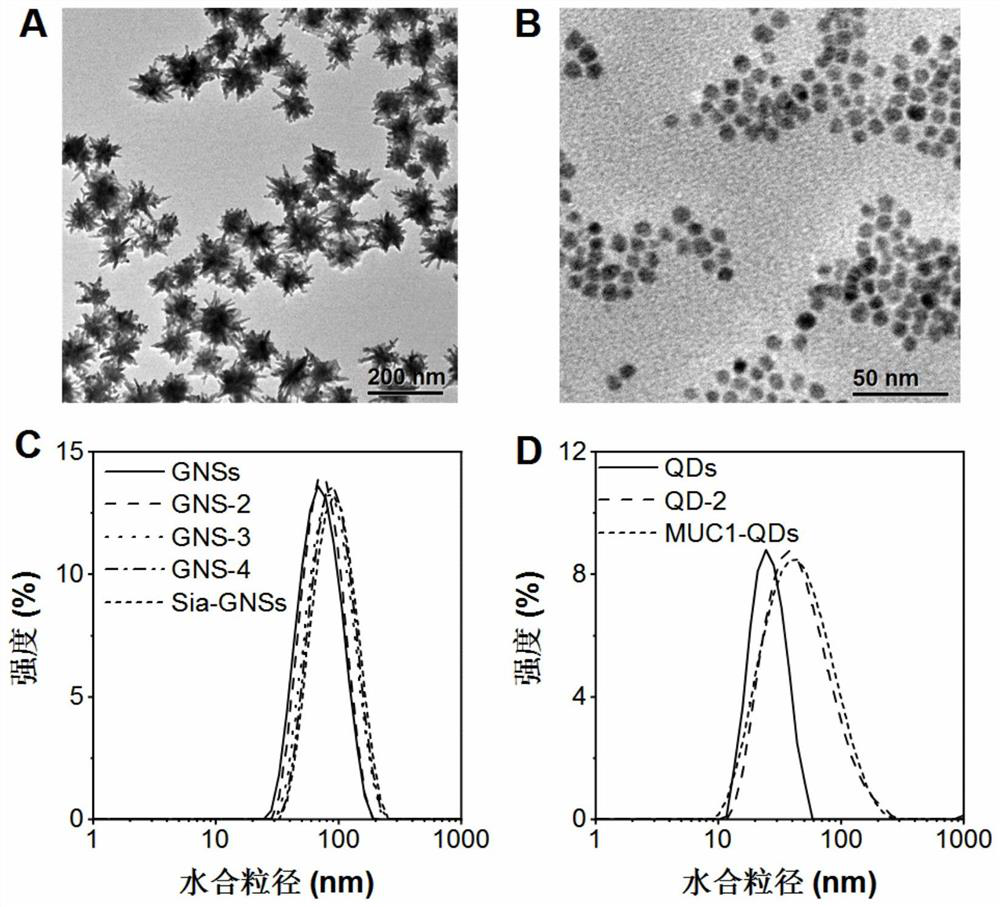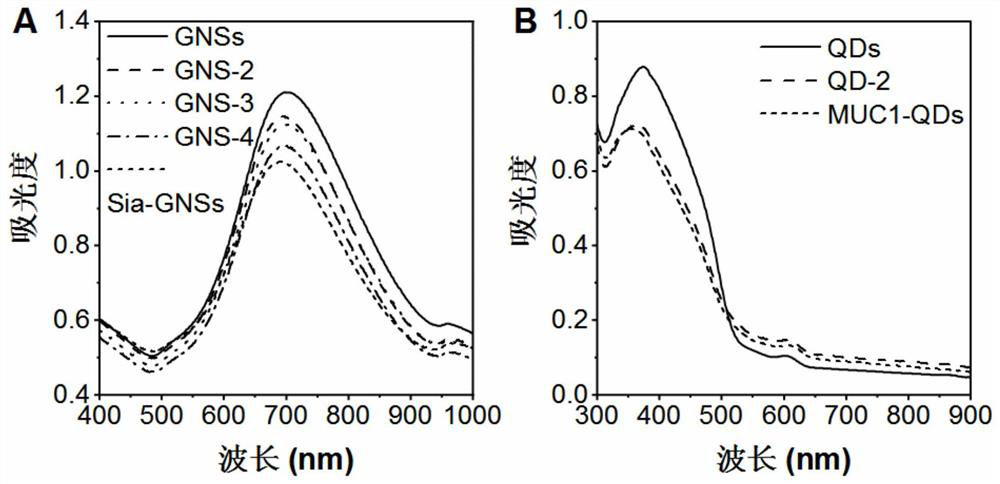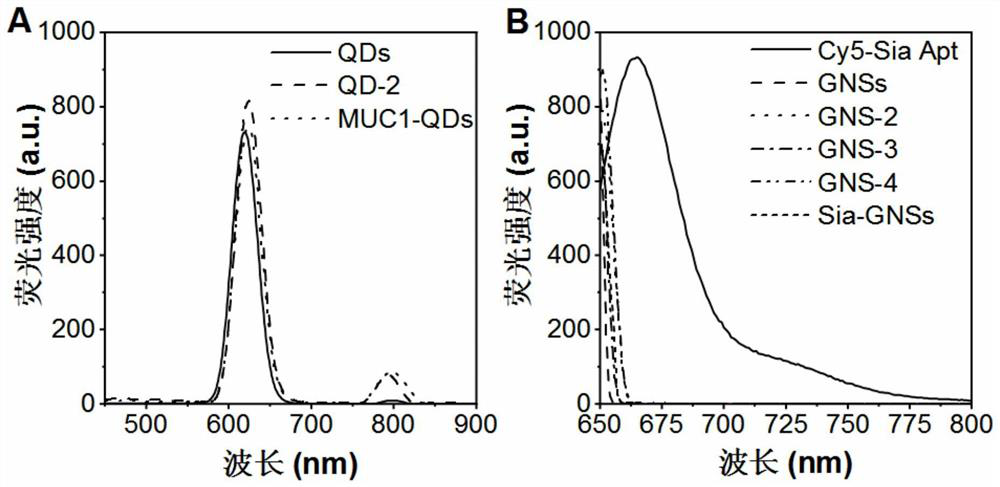Dual fluorescence imaging method of mucoprotein 1 and sialyl glycosyl thereof and application
A technology of sialic acid and mucin, which is applied in the field of fluorescence imaging and biomedicine, can solve the problems of complex analysis and lack of specificity, and achieve high specificity and biocompatibility, low cytotoxicity, and strong fluorescence penetration ability Effect
- Summary
- Abstract
- Description
- Claims
- Application Information
AI Technical Summary
Problems solved by technology
Method used
Image
Examples
Embodiment 1
[0048] Embodiment 1: the synthesis of Sia-GNSs nanoprobe
[0049] (1) Synthesis of gold nanostars GNSs (gold nanostars)
[0050] All glass instruments were soaked in aqua regia, washed with double distilled water, and dried for later use. Gold nanostars were prepared by seed crystal growth method. The water used in the following steps is 18.2 MΩ Milli-Q ultrapure water.
[0051] The synthesis steps of gold nanostars are:
[0052] (1) Synthesis of seed crystals: 100mL of 1mM tetrachloroauric acid trihydrate is placed in a reaction flask, heated and stirred at 100°C until boiling, then 15mL of sodium citrate solution with a concentration of 10g / L is added, and boiled for 15 minutes to make The color of the solution changed from light yellow to wine red. Cool to room temperature, filter with a 0.22 μm membrane filter, and store in a refrigerator at 4°C.
[0053] (2) Preparation of gold nanostars: After the seed crystal solution in step (1) is synthesized, the gold nanostars ...
Embodiment 2
[0061] Embodiment 2: the synthesis of MUC1-QDs nanoprobe
[0062] (1) Quantum dots and MUC1 aptamers are coupled to synthesize QD-2:
[0063] Carboxyl water-soluble CdSe@ZnS quantum dots were purchased from Wuhan Jiayuan Quantum Dot Technology Development Co., Ltd. Add 4 μL of EDC with a concentration of 0 mg / mL and 1.6 μL of NHS with a concentration of 10 mg / mL to 80 μL of PBS solution containing 2 μM QDs, react at room temperature for 1 hour, and then add 80 μL of MUC1 aptamer with a concentration of 100 μM (sequence: 5'-NH 2 -C 6 -GCAGTTGATCCTTTGGATACCCTGG-3'), mix well, shake at room temperature for 2 hours. Centrifuge at 13,000 rpm for 10 minutes, and then disperse in 80 μL of PBS to obtain QD-2.
[0064] (2) QD-2 and the aminated polyethylene glycol (NH 2 -PEG2000) coupling to synthesize MUC1-QDs:
[0065] Add 4 μL of 10 mg / mL EDC and 1.6 μL of 10 mg / mL NHS to the QD-2 prepared in step (1), react at room temperature for 1 hour, and then add 10 μL of 10 mg / mL NHS 2...
Embodiment 3
[0067] Embodiment 3: the stability test of nanoprobe
[0068] Stability is one of the most important properties of nanocarriers. Nanoparticles used in the field of biomedicine must be able to be stably dispersed in a certain concentration range of salt solution or medium. Dilute the nanoprobe Sia-GNSs prepared in Example 1 and the nanoprobe MUCl-QDs prepared in Example 2 into aqueous solution, phosphate buffer (PBS, pH=7.4) and high-glucose medium containing 10% fetal bovine serum (DMEM), the concentration after dilution is 0.1nM, and its particle size change within 7 days is measured by DLS, so as to judge its stability. The result is as Figure 4 As shown, there is no obvious particle size change within 7 days, indicating that the two nanoprobes have good stability.
PUM
| Property | Measurement | Unit |
|---|---|---|
| Concentration | aaaaa | aaaaa |
| Particle size | aaaaa | aaaaa |
| Thickness | aaaaa | aaaaa |
Abstract
Description
Claims
Application Information
 Login to View More
Login to View More - R&D
- Intellectual Property
- Life Sciences
- Materials
- Tech Scout
- Unparalleled Data Quality
- Higher Quality Content
- 60% Fewer Hallucinations
Browse by: Latest US Patents, China's latest patents, Technical Efficacy Thesaurus, Application Domain, Technology Topic, Popular Technical Reports.
© 2025 PatSnap. All rights reserved.Legal|Privacy policy|Modern Slavery Act Transparency Statement|Sitemap|About US| Contact US: help@patsnap.com



